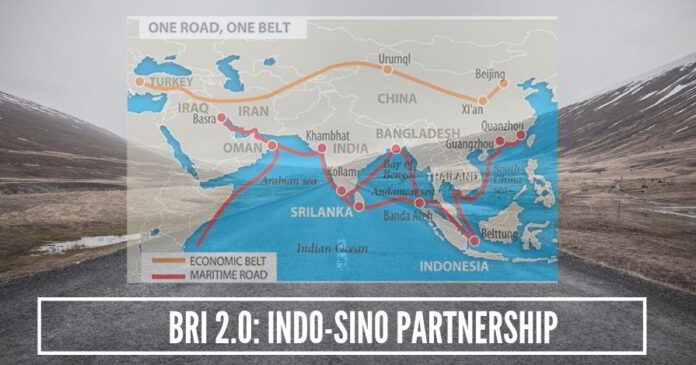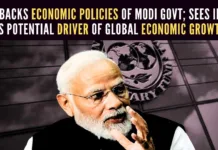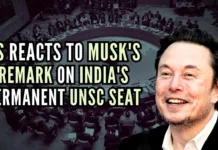
India and China could work on this new economic corridor that will integrate India, China and the whole South Asia region by connecting India to China-Indochina Peninsula Economic corridor of Greater Mekong region
China’s President Xi Jinping had announced the One Belt One Road (OBOR) in 2013, inspired from the two millennia old concept of the Silk Road during the Han Dynasty. In 2016, it was renamed as the Belt and Road Initiative (BRI) with the objective of increasing trade and commerce and enhancing connectivity of Eurasian countries. This is aimed to be achieved by infrastructure-driven economic growth through the development of infrastructure facilities, including railways, roadways, airways, optical fibre lines, oil and natural gas pipelines, ports etc. The funding in the form of loans is to be provided by the Asian Infrastructure Investment Bank (AIIB) and expertise for infrastructure projects by Chinese companies. This vast project will result in new trade and manufacturing hubs, along with new and large unified markets and an increase in cultural exchange and integration.
Role of India
China and other Indian neighbours have requested India to participate in this project.[i] India held a crucial role in the ancient silk road and it could play a significant role in BRI due to its strategic positioning, large market, political stability and potential for large scale manufacturing due to cheap labour, which could result in seamless connectivity of the region, trade expansion and cultural exchange and integration. India’s participation could take the project to a whole new level and the resulting increase in trade and connectivity would be beneficial for the whole region. Further, transiting goods through various Indian routes would be reliable, secure, cost-effective and faster as it will significantly shorten the trade routes. Also, India’s presence would further increase the credibility of the project.
China is also planning to import gas from Russia through the Altai gas pipeline. If India joins this project, then the price and project could become viable for both China and India
Overlapping Interests
The needs of both India and China are similar in the sense that both countries want to expand trade and commerce, need stable trade routes, need reliable imports like oil and gas from other countries etc. Both countries also want to reduce the risk arising out of geopolitical disruptions like Arab spring, Iran sanctions, Qatar-gulf crisis, Iraq war and subsequent occupation by ISIS etc. in the past. The conflicts in the middle east could also disrupt trade routes like during Suez Crisis and similar risks to close the strait of Hormuz now.
Both India and China are among the top three consumers of oil and gas and both want price stability and energy security through diversification of sources and reduction in price. The lower price could be achieved by increasing the negotiation power through creating a common bloc along with Japan, South Korea etc. for purchase of oil and gas. Energy security could be achieved by connecting various sources of imports through land and sea, by adding new suppliers and routes and by increasing the viability of new projects through cooperation like Qatar-India undersea gas pipeline etc.
India’s Interests
India has not participated in the project due to its objections regarding sovereignty over Pakistan occupied Indian territory through which the Karakoram highway passes. However, with the right assurances and security agreements, this issue could be resolved. India’s participation in the project will give a boost to the Indian economy through the development of infrastructure and increase in FDI. The project has the potential to make India and China largest trade partners. India’s participation could result in the development of three new economic corridors which have been discussed in brief below.
India China Economic Corridor through Ladakh
China wants to develop its northwest Xinjiang region but as it is a landlocked région, it needs connectivity to sea for exports. At present, China is working with Pakistan to connect that region to sea through the China Pakistan Economic Corridor (CPEC) and India could also become a partner in this endeavour. At present Kashgar in China is connected to Skardu in Pakistan occupied territory through Gilgit via Karakoram highway and Skardu is further connected to Kargil in India through Skardu-Kargil road, part of the ancient Silk Route. But that route is currently not operational due to political issues. Kargil is already connected to Mumbai through Leh, Manali, Patiala, Rewari, Delhi and the route overlaps with Delhi Mumbai Economic Corridor (DMIC). The length of the route (~ 3200 km from Gilgit to Mumbai) is similar to the existing route between Gwadar and Xinjiang. The basic road infrastructure is already there, and it only needs up-gradation to make it viable round the year and to handle the additional cargo. India is also working on it with projects like Rohtang pass tunnel etc.[ii] The same route could also be connected through rail by connecting Kargil to Kashgar through planned Karakoram railway and India is also working on it with projects like Bilaspur–Mandi–Leh railway etc.[iii]
India could also import oil and gas through this route from Central Asian countries. India has planned gas import from Turkmenistan through TAPI (Turkmenistan Afghanistan Pakistan India) pipeline, which passes through routes controlled by the Taliban and which would thus be unreliable, risky and costly. With the US plan to withdraw its troops from Afghanistan, there is additional uncertainty regarding the stability of the region.[iv] Instead, India could use this new route to import gas by extending China’s Central-Asia-China gas pipeline to India. Kazakhstan–China oil pipeline is another pipeline which could be extended to import oil.
China is also planning to import gas from Russia through the Altai gas pipeline. If India joins this project, then the price and project could become viable for both China and India. India could import gas through this new route. The oil and gas imports to India from Qatar, Iran, Saudi Arabia, UAE etc. via sea could also be exported to China through this route.
India is working on new trade routes to various South Asian countries to increase trade through initiatives like Mekong–Ganga Cooperation
The route will also provide China access to Indian markets and its ports and it would be shorter, reliable and safer and it will complement the existing CPEC project. The route will also provide India and other South Asian countries access to Central Asian countries, Russia, Nordic countries and Europe through Eurasian Land Bridge and China-Central Asia-West Asia Economic Corridor.
India is already a member of Ashgabat agreement and other countries in Shanghai Cooperation Organization (SCO) could also be included in it to create international transport and transit corridor, which will provide seamless connectivity to the whole region. China could also consider providing India limited access to Afghanistan via Wakhjir pass through this route.
Both Gilgit-Baltistan and Kargil are Shia dominated, where people have old cultural ties and there is also people’s demand to connect the Greater Ladakh region by connecting Gilgit-Baltistan in Pakistan occupied territory with Ladakh region in India. [v] This will improve both economic and cultural ties in these regions.
Indian China Economic Corridor through Lhasa
India could also have a direct route that could connect India to China either through Jelep La or Nathu La pass in India, which was also part of the ancient Silk road and Yadong in China. The route involves no other country and thus it could emerge as the shortest, safest and cheapest route for import and export, bypassing the Straits of Malacca and the South China Sea. The basic infrastructure that connects Yadong to Lhasa to Chengdu on China side and Siliguri to Gangtok to Nathu La on India side is already there. The route could also be connected through train by extending Qinghai-Tibet Railway from Shigatse to Yadong in China and by extending Sevoke to Nathu La or Jelep La in India.
The route could also be used by China for oil and gas import by connecting major Chinese cities with Kolkata through direct pipelines. As per China’s pact with Russia, it will import gas from Russia through Power of Siberia pipeline & Sakhalin–Khabarovsk–Vladivostok pipeline and it will import oil through Eastern Siberia–Pacific Ocean oil pipeline (ESPO pipeline). India could also become a partner and import oil and gas from Russia by extending these pipelines through this route, which will ensure a constant demand for Russia. Both countries could be connected through pipelines by extending the pipelines from Chengdu in China to India. India could also partner in any future pact to import oil from Canada through the Trans Mountain pipeline, thus increasing its viability.
Sino Indo Myanmar (SIM) Economic Corridor
As per India’s Act East policy, India is working on new trade routes to various South Asian countries to increase trade through initiatives like Mekong–Ganga Cooperation. China and Myanmar are already part of China Myanmar Economic Corridor (CMEC), under which Kunming in Yunnan Province of China will be connected to Kyaukpyu Special Economic Zone of Myanmar through Mandalay and Yangon and the route will also be used to import oil, gas and other goods. India, Myanmar and China are already part of Bangladesh, China, India and Myanmar Economic Corridor (BCIM) but it has not seen much success. Instead, India and China could work on this new economic corridor that will integrate India, China and the whole South Asia region by connecting India to China-Indochina Peninsula Economic corridor of Greater Maykong region.
From Guwahati in India, there are two routes for India to connect to Myanmar viz., upper and lower. The lower route connects Guwahati to Moreh at Indian border via Imphal and then to Mandalay region of Myanmar and Mandalay is already connected with China’s Kunming region through Muse at Myanmar border. The upper route will revive the old Ledo road which will connect Guwahati to Muse through Ledo and Bhamo, which could be used for laying oil and gas pipelines due to its terrain.
India went in war with China due to mutual misunderstandings and Indian PM Mr Modi also appreciated the fact that not a single bullet has been fired across the border in 40 years despite border dispute
Geopolitical Issues and Challenges
China has already declared that PoK is a bilateral matter between India and Pakistan and it has also declared that India’s participation in the BRI project will not alter the existing situation. Further, China’s ambassador to India proposal to rename the CPEC along with other assurances if India comes on board indicates China’s will and readiness to accommodate India concerns.[vi] With such assurances, India should have a low concern regarding its participation. China is already planning to deploy 30,000 troops in Gilgit-Baltistan for the security of its project and if there is an agreement to deploy India-China joint troops along the corridors will further reduce India’s apprehensions and make the route more secure and stable.[vii]
At present, both countries would lose by making trade a zero-sum game by competing in Indian Ocean region and in other countries but if both countries instead create an alliance then there would be a great synergy of efforts and it would result in better outcomes with reduced cost and risks. The issue of militarization of Indian ocean will also become irrelevant. All the participating countries want stable trade routes free from disruption from threats like terrorism and the combined efforts could lead to better security and stability.
China has concerns about a deep state of Pakistan and their cultivated terror groups regarding the safety of the project and for providing safe haven and training to Uyghur extremists and is worried about the way their project is going in the same direction as Suez project.[viii],[ix],[x] To allay such fears, the Pakistan army has deployed more than 15000 troops for security.[xi] Despite that there have been incidents like attacks, killings and kidnapping of Chinese citizens, spreading of fake news during Doklam standoff to escalate tensions etc.[xii],[xiii] Now China has deployed its 16000 soldiers in Sindh and Baloch regions which indicates that either China is not convinced with the ability of Pakistan Army to provide safety or they are losing faith in Pak establishment.[xiv]
Conclusion
China is keen to bring India on board as indicated from the unsolicited proposal of the Chinese ambassador. India and China had trade and cultural ties since ancient times and Buddhism also spread to China from India with the travel of monks like Buddhabhadra, Bodhidharma, Xuanzang etc. The conflicts between two countries after India’s Independence over unresolved issues left by colonial empire should be seen as an anomaly in the long history and there is no benefit in prolonging dispute among two giants.[xv] We live in the interconnected and interdependent world where we all benefit by cooperation and not by creating blocs. India’s participation would be of great importance as well as beneficial to the whole world.
India went in war with China due to mutual misunderstandings and Indian PM Mr Modi also appreciated the fact that not a single bullet has been fired across the border in 40 years despite border dispute.[xvi] What both countries need is the settlement of border dispute through some ingenious thinking using some quid pro quo. Due to resulting interdependence, the project has the potential to push both countries towards resolving long pending border disputes. It could also lead to signing a friendship treaty and bilateral free trade agreement in future.
India’s participation will also be greatly beneficial to South Asian countries due to its strategic position as it would connect those countries with the Indian market and provide a shorter and alternative route to Central Asian and European countries. The project is futuristic, and it could emerge as a backbone for massive volume of trade among Asian countries.
[i] https://www.newdelhitimes.com/worried-pakistan-pleads-india-to-join-cpec/
[ii] https://www.tribuneindia.com/news/himachal/bro-sets-ball-rolling-for-tunnel-under-baralacha/671762.html
[iii] https://www.businesstoday.in/latest/trends/bilaspur-manali-leh-railway-line-all-you-need-to-know/story/313298.html
[iv] https://www.nytimes.com/2018/12/20/us/politics/afghanistan-troop-withdrawal.html
[v] https://www.theweek.in/news/india/2019/02/01/hundreds-march-in-kargil-to-demand-opening-of-kargil-skardu-road.html
[vi] https://www.business-standard.com/article/current-affairs/chinese-offer-to-rename-cpec-if-india-joins-obor-could-be-in-play-again-117112400312_1.html
[vii] https://economictimes.indiatimes.com/news/defence/chinese-army-troops-spotted-along-line-of-control-in-pakistan-occupied-kashmir/articleshow/51380320.cms
[viii] https://www.nytimes.com/2011/08/02/world/asia/02china.html
[ix] https://timesofindia.indiatimes.com/world/china/WikiLeaks-show-Uighur-rebels-trained-in-Pakistan/articleshow/8231059.cms
[x] https://timesofindia.indiatimes.com/world/china/xinjiang-leaders-talk-of-pakistan-links-with-local-terrorists/articleshow/56462369.cms
[xi] https://economictimes.indiatimes.com/news/defence/china-to-authorise-pakistan-to-build-missiles-tanks-fc-1-xiaolong-combat-aircraft/articleshow/57684105.cms
[xii] https://economictimes.indiatimes.com/news/defence/china-to-authorise-pakistan-to-build-missiles-tanks-fc-1-xiaolong-combat-aircraft/articleshow/57684105.cms
[xiii] https://www.indiatimes.com/news/india/china-exposes-pak-media-s-fake-news-denies-killing-158-indian-soldiers-during-current-standoff-326085.html
[xiv] https://www.dnaindia.com/world/report-just-90-km-away-from-indo-pak-border-china-deploys-troops-in-sindh-2731702
[xv] https://www.brookings.edu/blog/order-from-chaos/2017/10/13/china-india-relations-millennia-of-peaceful-coexistence-meet-modern-day-geopolitical-interests/
[xvi] https://timesofindia.indiatimes.com/india/not-a-single-bullet-fired-in-40-years-despite-border-dispute-with-china-pm-modi/articleshow/58966132.cms
- Chess board at Ladakh: The China dilemma - October 31, 2020
- CAA: A small step towards Humanity - March 7, 2020
- Assessment of Modi government’s first term - May 16, 2019











[…] BRI 2.0: Indo-Sino Partnership – Apr 18, 2019, […]
Power comes from the barrell of a gun, not by becoming serfs of Chinese Imperialist dictators
China and Pakistan are back stabber no one can trust them. If there are so many advantages, China can simply settle the border dispute give up Kailas Mansarovar, and force Pakistan to give up Gilgit Baltistan. If so much advantages are there why China is acting like a Chutiya. Because of Ego and they have to eat shit for 1962.